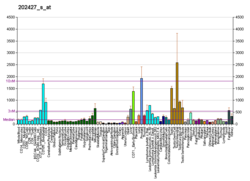
Zinc finger protein 43 is a protein that in humans is encoded by the ZNF43 gene.

CTTNBP2 N-terminal-like protein is a protein that in humans is encoded by the CTTNBP2NL gene. It is a substrate for phosphorylation.

39S ribosomal protein L15, mitochondrial is a protein that in humans is encoded by the MRPL15 gene.

Transmembrane protein 47 is a protein that in humans is encoded by the TMEM47 gene.

Dehydrogenase/reductase SDR family member 1, also known as Short chain dehydrogenase/reductase family 19C member 1 is an enzyme that in humans is encoded by the DHRS1 gene located on chromosome 14.

Zinc transporter 7 is a protein that in humans is encoded by the SLC30A7 gene.

NADH dehydrogenase [ubiquinone] 1 subunit C2 is an enzyme that in humans is encoded by the NDUFC2 gene.

Hippocalcin like 4, also known as HPCAL4, is a human gene.

AP-1 complex-associated regulatory protein is a protein that in humans is encoded by the AP1AR gene.

Synaptotagmin-13 is a protein that in humans is encoded by the SYT13 gene.

KANSL3, or KAT8 regulatory NSL complex subunit 3 is a protein that in humans is encoded by the KANSL3 gene.

Ankyrin repeat domain-containing protein 13C is a protein that in humans is encoded by the ANKRD13C gene.

Polycomb group RING finger protein 5 is a protein that in humans is encoded by the PCGF5 gene.

Opalin is a protein that is encoded in humans by the OPALIN gene.

Transmembrane and TPR repeat-containing protein 2 is a protein that in humans is encoded by the TMTC2 gene.

Sodium/bile acid cotransporter 7 is a protein which in humans is encoded by the SLC10A7 gene.

Protein FAM186B is a protein that in humans is encoded by the FAM186B gene.

Transmembrane protein 117 is a protein that in humans is encoded by the TMEM117 gene.

60S ribosomal protein L10-like is a protein that in humans is encoded by the RPL10L gene.

Mitochondrial pyruvate carrier 1 (MPC1), also known as brain protein 44-like (BRP44L) and SLC54A1, is a protein that in humans is encoded by the MPC1 gene. It is part of the Mitochondrial Pyruvate Carrier (MPC) protein family. This protein is involved in transport of pyruvate across the inner membrane of mitochondria in preparation for the pyruvate dehydrogenase reaction.


















